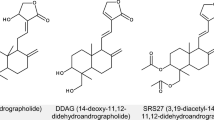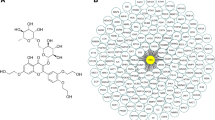Abstract
Solidagenone, a labdane diterpene isolated from inflorescences of Solidago chilensis Meyen, Asteraceae, was investigated for its anti-inflammatory and anti-asthmatic action. Allergic pleurisy and allergic lung inflammation assays were performed at doses of 1, 10, 50, and 100 mg/kg in ovalbumin-sensitized mice. In vitro cytotoxicity was performed, using the [3-(4,5-dimethylthiazol-2-yl)-2,5-diphenyl tetrazolium bromide] MTT assay in a murine J774A1 macrophage cell line and human blood cells at concentrations of 0.1–100 µg/ml, as well as genotoxicity using the comet assay. In addition, in silico predictions were performed using ADMET Predictor TM software to predict absorption, distribution, metabolism, excretion, and toxicity. This study showed the anti-inflammatory activity and the possibility of an anti-asthmatic action of solidagenone at a concentration of 6 mg considering calculations for adult humans. Furthermore, it was possible to assess toxicity in vitro under the conditions performed and compare it with the in silico predictions.
Graphical Abstract



Similar content being viewed by others
References
Bhatti HN, Khera RA (2014) Biotransformations of diterpenoids and triterpenoids: a review. J Asian Nat Prod Res 16:70–104. https://doi.org/10.1080/10286020.2013.846908
Bortoleti BTS, Gonçalves MD, Tomiotto-Pellissier F, Contato VM, Silva TF, de Matos RLN, Detoni MB, Rodrigues ACJ, Carloto AC, Lazarin DB, Arakawa NS, Costa IN, Conchon-Costa I, Miranda-Sapla MM, Wowk PF, Pavanelli WR (2021) Solidagenone acts on promastigotes of L. amazonensis by inducing apoptosis-like processes on intracellular amastigotes by IL-12p70/ROS/NO pathway activation. Phytomedicine 85:153536. https://doi.org/10.1016/j.phymed.2021.153536
Cuadrado I, Amesty Á, Cedrón JC, Oberti JC, Estévez-Braun A, Hortelano S, de las Heras B (2018) Semisynthesis and inhibitory effects of solidagenone derivatives on TLR-mediated inflammatory responses. Molecules 23:3197. https://doi.org/10.3390/molecules23123197
De Brito TM, Amendoeira FC, de Oliveira TB, Frutuoso VS, Ferraris FK, Valverde SS (2020) Extract of Solidago chilensis Meyen inflorescences: cytotoxicity and inhibitory activity on nitric oxide synthesis in activated macrophage cell line J774A.1. Braz J Pharm Sci 56:e17707. https://doi.org/10.1590/s2175-97902020000117707
El-Saadi MW, Williams-Hart T, Salvatore BA, Mahdavian E (2015) Use of in-silico assays to characterize the ADMET profile and identify potential therapeutic targets of fusarochromanone, a novel anti-cancer agent. In Silico Pharmacol 3:6. https://doi.org/10.1186/s40203-015-0010-5
Ferraris FK, Moret KH, Figueiredo ABC, Penido C, Henriques MDGMO (2012) Gedunin, a natural tetranortriterpenoid, modulates T lymphocyte responses and ameliorates allergic inflammation. Int Immunopharmacol 14:82–93. https://doi.org/10.1016/j.intimp.2012.06.002
Freireich EJ, Gehan EA, Rall DP, Schmidt LH, Skipper HE (1966) Quantitative comparison of toxicity of anticancer agents in mouse, rat, ramster, dog, monkey, and man. Cancer Chemoth Rep 50:219–244
Gastaldi B (2018) Solidago chilensis Meyen (Asteraceae), a medicinal plant from South America. A comprehensive review: ethnomedicinal uses, phytochemistry and bioactivity. B Latinoam Caribe Pl 17:17–29
Guan L, Yang H, Cai Y, Sun L, Di P, Li W, Liu G, Tang Y (2018) ADMET-score - a comprehensive scoring function for evaluation of chemical drug-likeness. Medchemcomm 10:148–157. https://doi.org/10.1039/c8md00472b
Guengerich FP (2008) Cytochrome p450 and chemical toxicology. Chem Res Toxicol 21:70–83. https://doi.org/10.1021/tx700079z
Harirforoosh S, Asghar W, Jamali (2013) Adverse effects of nonsteroidal antiinflammatory drugs: an update of gastrointestinal, cardiovascular and renal complications. J Pharm Pharm Sci 16:821–847. https://doi.org/10.18433/j3vw2f
Lopes DCDXP, De Oliveira TB, Viçosa AL, Valverde SS, Ricci Júnior E (2021) Anti-inflammatory activity of the Compositae family and its therapeutic potential. Planta Med 87:71–100. https://doi.org/10.1055/a-1178-5158
Nair A, Jacob S (2016) A simple practice guide for dose conversion between animals and human. J Basic Clin Pharm 7:27–31. https://doi.org/10.4103/0976-0105.177703
Peach ML, Zakharov AV, Liu R, Pugliese A, Tawa G, Wallqvist A, Nicklaus MC (2012) Computational tools and resources for metabolism-related property predictions. 1. Overview of publicly available (free and commercial) databases and software. Future Med Chem 4:1907–1932. https://doi.org/10.4155/fmc.12.150
Razmilic I, Schmeda-Hirschmann G (2000) Activity of solidagenone and their semisynthetic derivatives on the glucocorticoid-mediated signal transduction. Planta Med 66:86–88. https://doi.org/10.1055/s-0029-1243119
Russo A, Garbarino J (2008) Solidago chilensis Meyen and Kageneckia oblonga Ruiz & Pav.: a minireview on their antioxidant profile. Phytothérapie 6:333–341. https://doi.org/10.1007/s10298-008-0345-8
Valverde SS, Santos BCS, de Oliveira TB, Gonçalves GC, de Sousa OV (2021) Solidagenone from Solidago chilensis Meyen inhibits skin inflammation in experimental models. Basic Clin Pharmacol 128:91–102. https://doi.org/10.1111/bcpt.13479
Valverde-Soares SS, Azevedo-Silva RC, Tomassini TCB (2009) Utilização de CLAE, como paradigma na obtenção e controle do diterpeno solidagenona a partir de inflorescências de Solidago chilensis Meyen (arnica brasileira). Rev Bras Farm 90:196–199
Vasconcelos JF, Santos IP, Oliveira TB, Kelly AM, Claro do Reis BPZ, Orge ID, Meira CS, Valverde SS, Soares MBP (2022) The protective effect of solidagenone from Solidago chilensis Meyen in a mouse model of airway inflammation. Basic Clin Pharmacol 130: 44-55. https://doi.org/10.1111/bcpt.13672
vonRanke NL, Ribeiro MMJ, Miceli LA, de Souza NP, Abrahim-Vieira BA, Castro HC, Teixeira VL, Rodrigues Souza AMT (2020) Structure-activity relationship, molecular docking, and molecular dynamic studies of diterpenes from marine natural products with anti-HIV activity 40:3185–3195. J Biomol Struct Dyn. https://doi.org/10.1080/07391102.2020.1845977
Wang M, Dai H, Li X, Li Y, Wang L, Xue M (2010) Structural elucidation of metabolites of tanshinone I and its analogue dihydrotanshinone I in rats by HPLC-ESI-MSn. J Chromatogr B 878:915–924. https://doi.org/10.1016/j.jchromb.2010.02.014
Zhang F, Bartels M, Clark A, Erskine T, Auernhammer T, Bhhatarai B, Wilson D, Marty S (2018) Performance evaluation of the GastroPlusTM software tool for prediction of the toxicokinetic parameters of chemicals. SAR QSAR Environ Res 29:875–893. https://doi.org/10.1080/1062936X.2018.1518928
Zhang X, Ye M, Gong Y, Feng L, Tao S, Yin J, Guo D (2011) Biotransformation of pseudolaric acid B by Chaetomium globosum. Process Biochem 46:2064–2067. https://doi.org/10.1016/j.procbio.2011.07.019
Acknowledgements
The authors appreciate Dr. Ana Paula dos Santos Matos from UFRJ and Dr. Ludmila Rosa Bergsten Torralba from Fiocruz for their help in organizing some experimental data.
Funding
This paper was financially supported by Carlos Chagas Filho Foundation for Research Support of Rio de Janeiro State (FAPERJ), INOVA Fiocruz program, Coordenação de Aperfeiçoamento de Pessoal de Nível Superior (CAPES), and Conselho Nacional de Desenvolvimento Científico e Tecnológico (CNPq) (PROEP Farmanguinhos). This work was supported by the FAPERJ by Edital Cientista do Nosso Estado 2020 (CNE: E-26/201.077/2021) and Edital Apoio aos Programas e Cursos de Pós-Graduação Stricto Sensu do Estado do Rio de Janeiro 2020 (E-26/210.136/2021).
Author information
Authors and Affiliations
Contributions
DCDXPL: designed the study, performed experiments, analyzed results, and wrote the manuscript; TMB, FKF, TRC, TRM, AMTS, BAV, and TBO: performed experiments and analyzed results; DAG and RSO: proofread and edited the work; ALV, SSV, and ERJr supervised the work and conceptualized the study. All authors have read, reviewed, and approved the manuscript.
Corresponding author
Ethics declarations
Ethical Approval
This research project involving the use of human blood samples was approved by the Committee on Ethics in Research with Human Beings of the National Institute of Infectious Diseases Evandro Chagas-INI/FIOCRUZ under Ethical Assessment Presentation Certificate number 52788721.5.0000.5262. All experimental procedures were performed in accordance with the Ethics Committee on the Use of Laboratory Animals of the Oswaldo Cruz Foundation under license LW-7/19, Protocol P9/18-5.
Supplementary Information
Below is the link to the electronic supplementary material.
Rights and permissions
Springer Nature or its licensor (e.g. a society or other partner) holds exclusive rights to this article under a publishing agreement with the author(s) or other rightsholder(s); author self-archiving of the accepted manuscript version of this article is solely governed by the terms of such publishing agreement and applicable law.
About this article
Cite this article
Lopes, D.C.D.X.P., de Brito, T.M., Ferraris, F.K. et al. Investigation of the Anti-asthmatic Activity of Solidagenone, In Vitro Toxicity Versus In Silico Studies. Rev. Bras. Farmacogn. 34, 280–287 (2024). https://doi.org/10.1007/s43450-023-00479-3
Received:
Accepted:
Published:
Issue Date:
DOI: https://doi.org/10.1007/s43450-023-00479-3




